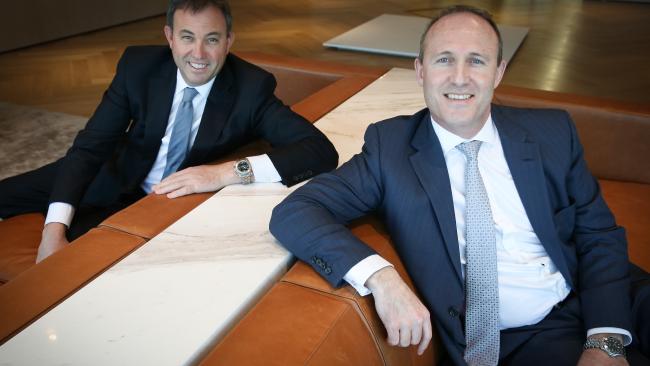Refine results
Hot Topics
Private Wealth Management cutting advisors grid commissions
Private Wealth Management cutting advisors grid commissions
We are witnessing rapid transformation in the Private Wealth Management industry, a great example being the strategy of Crestone Wealth Management which uses a number of different payment approaches. While many organisations are reducing their pay grid, Crestone ‘s advisors, who are largely owners of the business, are incentivised by deriving revenue from a basis point charge on client’s assets under management rather than transaction. What are your thoughts on this approach and what other innovative payment approaches have you seen emerging in the market?
My comments are based on the article below, published by the Australian.
UBS offshoot Crestone debuts its bespoke wealth management arm
THE AUSTRALIAN – 12:00AM JUNE 17, 2016, Michael Bennet Reporter, Sydney

UBS Australasia chief executive Matthew Grounds and Mike Chisholm of Crestone. Picture: Renee Nowytarger.
It has taken more than a year but the nation’s newest wealth management business believes it was time well spent.
“The finance industry is going through a lot of change,” Mike Chisholm, the chief of Crestone — the rebadged UBS wealth management arm — told The Australian as operations began this week.
“We thought long and hard about the business model we wanted to operate … and think we’ve set a business up that is aligned with all the big changes that are happening.
“Other businesses who are still entrenched in old business practices and models, they are the ones who are going to struggle with these (industry) changes.”
Along with shifting adviser remuneration and client fee models, wealth management businesses are seeing industry superannuation funds bulk up in the space, most recently First State Super via the $1 billion purchase of financial planning business StatePlus.
Since UBS revealed in May last year that the wealth arm would be offloaded to staff, Mr Chisholm said Crestone had sculpted a unique offering leveraging the latest Avaloq platform technology and partnerships with UBS, Commonwealth Bank, Credit Suisse and Northern Trust.
“That’s one of the benefits of being able to build from the ground up — a bespoke business tailored for the environment and where we see things going in the future,” he said, brushing off the threat from super funds.
After finalising the acquisition last Friday from UBS for an undisclosed price, Crestone spent the weekend nervously transferring more than $14bn of assets.
Despite clients not being able to trade until Tuesday, Mr Chisholm said few concerns were raised, the local stockmarket was shut on Monday and the migration went swimmingly.
Matthew Grounds, chief of UBS Australasia, said: “In Australia I don’t think this has been done before — where such a large number of clients and assets have been migrated from an incumbent bank system on to a new platform in one weekend after nearly a year of planning.”
Mr Grounds said the bank opted to sell the wealth arm because it was “quite small in a global sense … and from a scalability perspective, it didn’t hit the metrics”.
He said Crestone would benefit from a partnership approach where there was “alignment between advisers, management and clients”, noting UBS’s investment bank had such a culture.
“The reality is, this wealth business is really suited to a partnership,” he said of the deal, which brings UBS into line with most foreign investment banks that leverage alliances rather than having in-house wealth arms.
UBS will provide Crestone with securities execution, clearing and settlement, research, access to capital markets deals and managed funds. “For us, setting up Crestone made sense. I care about the people and the clients, so the best way is for them to create a partnership where they can invest in the business,” Mr Grounds said.
Last month, rival Morgan Stanley took the axe to commissions for 157 advisers in its $26bn wealth arm, warning that the industry was suffering “structural unprofitability” after years of rising costs and flat revenue.
Under Morgan Stanley’s new pay “grid”, many advisers’ share of the first $500,000 in revenue they write will decrease to 30 per cent, from 40 per cent.
Mr Chisholm said Crestone used a “number of different payment approaches” for advisers including a grid, but argued most advisers were owners and incentivised to boost the company’s profits to reap dividends. He said 80 per cent of Crestone’s revenue came from a basis-point charge on a client’s assets under management — rather than on transactions — which was “probably 10-15 years ahead” of the industry.
“An assets under management fee model aligns interest of the client, the firm and adviser because you’re all motivated to sustainably over the long term grow the value of that portfolio,” he said.
But Crestone’s formation has not been without hiccups, with advisers shrinking to 70, from about 90 a year ago. Of the 170 total staff spread across offices in Brisbane, Melbourne and Sydney, 85 are shareholders. Under the new strategy, Crestone willput its sole focus on high net worth individuals and family offices seeking diversified, multi asset-class portfolios.


